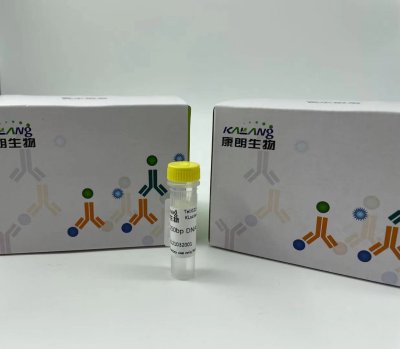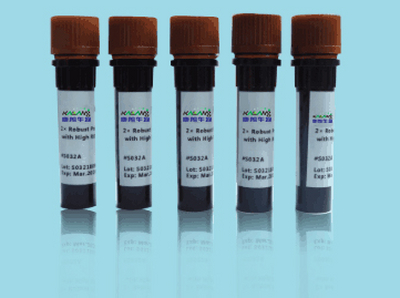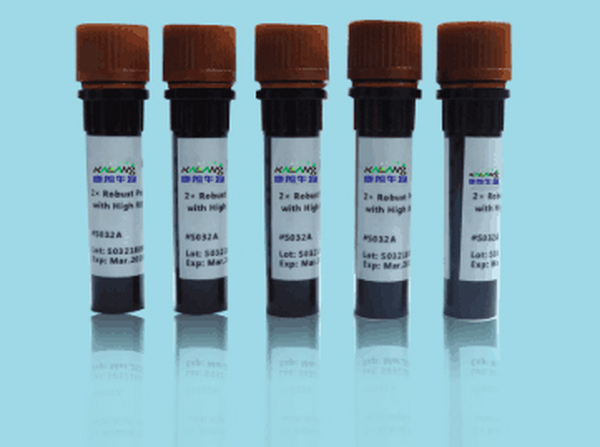QQ:3002763590


客服电话:021-61998208
FCRL2 rabbit Polyclonal Antibody
FCRL2抗体
FCRL2抗体应用:WB 1:500-2000 ELISA 1:5000-20000Fc receptor like 2(FCRL2) Homo sapiens This gene encodes a member of the immunoglobulin receptor superfamily and is one of several Fc receptor-like glycoproteins clustered on the long arm of chromosome 1. The encoded protein has four extracellular C2-type immunoglobulin domains, a transmembrane domain and a cytoplasmic domain that contains one immunoreceptor-tyrosine activation motif and two immunoreceptor-tyrosine inhibitory motifs. This protein may be a prognostic marker for chronic lymphocytic leukemia. Alternatively spliced transcript variants have been described, but their biological validity has not been determined. [provided by RefSeq, Apr 2009],
FCRL4 rabbit Polyclonal Antibody
FCRL4抗体
FCRL4抗体应用:WB 1:500-2000 ELISA 1:5000-20000Fc receptor like 4(FCRL4) Homo sapiens This gene encodes a member of the immunoglobulin receptor superfamily and is one of several Fc receptor-like glycoproteins clustered on the long arm of chromosome 1. The encoded protein has four extracellular C2-type immunoglobulin domains, a transmembrane domain and a cytoplasmic domain that contains three immune-receptor tyrosine-based inhibitory motifs. This protein may play a role in the function of memory B-cells in the epithelia. Aberrations in the chromosomal region encoding this gene are associated with non-Hodgkin lymphoma and multiple myeloma. [provided by RefSeq, Apr 2009],
FCRLB rabbit Polyclonal Antibody
FCRLB抗体
FCRLB抗体应用:WB 1:500-2000 ELISA 1:5000-20000Fc receptor like B(FCRLB) Homo sapiens FCRL2 belongs to the Fc receptor family. Fc receptors are involved in phagocytosis, antibody-dependent cell cytotoxicity, immediate hypersensitivity, and transcytosis of immunoglobulins via their ability to bind immunoglobulin (Ig) constant regions (Chikaev et al., 2005 [PubMed 15676285]).[supplied by OMIM, Mar 2008],
FETUB rabbit Polyclonal Antibody
FETUB抗体
FETUB抗体应用:WB 1:500-2000 ELISA 1:5000-20000fetuin B(FETUB) Homo sapiens The protein encoded by this gene is a member of the fetuin family, part of the cystatin superfamily of cysteine protease inhibitors. Fetuins have been implicated in several diverse functions, including osteogenesis and bone resorption, regulation of the insulin and hepatocyte growth factor receptors, and response to systemic inflammation. This protein may be secreted by cells. [provided by RefSeq, Jul 2008],
FEZ2 rabbit Polyclonal Antibody
FEZ2抗体
FEZ2抗体应用:WB 1:500-2000This gene is an ortholog of the C. elegans unc-76 gene, which is necessary for normal axonal bundling and elongation within axon bundles. Other orthologs include the rat gene that encodes zygin II, which can bind to synaptotagmin. [provided by RefSeq, Jul 2008],
FGD1 rabbit Polyclonal Antibody
FGD1抗体
FGD1抗体应用:WB 1:500-2000This gene encodes a protein that contains Dbl (DH) and pleckstrin (PH) homology domains and is similar to the Rho family of small GTP-binding proteins. The encoded protein specifically binds to the Rho family GTPase Cdc42Hs and can stimulate the GDP-GTP exchange of the isoprenylated form of Cdc42Hs. It also stimulates the mitogen activated protein kinase cascade leading to c-Jun kinase SAPK/JNK1 activation. Defects in this gene are the cause of faciogenital dysplasia and X-linked mental retardation, syndromatic 16.[provided by RefSeq, Mar 2011],
FGD4 rabbit Polyclonal Antibody
FGD4抗体
FGD4抗体应用:WB 1:500-2000This gene encodes a protein that is involved in the regulation of the actin cytoskeleton and cell shape. This protein contains an actin filament-binding domain, which together with its Dbl homology domain and one of its pleckstrin homology domains, can form microspikes. This protein can activate MAPK8 independently of the actin filament-binding domain, and it is also involved in the activation of CDC42 via the exchange of bound GDP for free GTP. The activation of CDC42 also enables this protein to play a role in mediating the cellular invasion of Cryptosporidium parvum, an intracellular parasite that infects the gastrointestinal tract. Mutations in this gene can cause Charcot-Marie-Tooth disease type 4H (CMT4H), a disorder of the peripheral nervous system. Multiple alternatively spliced transcript variants encoding different isoforms have been found for this gene. [provided by RefSeq, Jan 2015],
FGF10 rabbit Polyclonal Antibody
FGF10抗体
FGF10抗体应用:WB 1:500-2000 ELISA 1:5000-20000fibroblast growth factor 10(FGF10) Homo sapiens The protein encoded by this gene is a member of the fibroblast growth factor (FGF) family. FGF family members possess broad mitogenic and cell survival activities, and are involved in a variety of biological processes, including embryonic development, cell growth, morphogenesis, tissue repair, tumor growth and invasion. This protein exhibits mitogenic activity for keratinizing epidermal cells, but essentially no activity for fibroblasts, which is similar to the biological activity of FGF7. Studies of the mouse homolog of suggested that this gene is required for embryonic epidermal morphogenesis including brain development, lung morphogenesis, and initiation of lim bud formation. This gene is also implicated to be a primary factor in the process of wound healing. [provided by RefSeq, Jul 2008],
FGF14 rabbit Polyclonal Antibody
FGF14抗体
FGF14抗体应用:WB 1:500-2000 ELISA 1:5000-20000fibroblast growth factor 14(FGF14) Homo sapiens The protein encoded by this gene is a member of the fibroblast growth factor (FGF) family. FGF family members possess broad mitogenic and cell survival activities, and are involved in a variety of biological processes, including embryonic development, cell growth, morphogenesis, tissue repair, tumor growth and invasion. A mutation in this gene is associated with autosomal dominant cerebral ataxia. Alternatively spliced transcript variants have been found for this gene. [provided by RefSeq, Jul 2008],
最新动态
-

Anti-GNGT1 KL20092-001(50ul)
2021-10-11 -

Anti-GNGT1 antibody(50ul) KL20093-001
2021-10-11 -

MUC5AC (PT2058) mouse Monoclonal Antibody
2021-01-06 -

mOrange mouse Monoclonal Antibody(Mix)
2021-01-05
热门标签
- Histone H3 rabbit Polyclonal Antibody Histone H3抗体
- EGFR rabbit Polyclonal Antibody EGFR抗体
- Cy3 Conjugated
- AbFluor™ 555 Conjugated
- AbFluor™ 680 Conjugated
- AbFluor™ 350 Conjugated
- AbFluor™ 647 Conjugated
- AbFluor™ 594 Conjugated
- AbFluor™ 405 Conjugated
- Cy5 Conjugated
- AbFluor™ 488 Conjugated
- Cyclophilin B抗体 Cyclophilin B Monoclonal Antibody(2B10)
- COX IV抗体 COX IV Monoclonal Antibody(6C8)
- PCNA抗体 PCNA Monoclonal Antibody(12D10)
- FAK rabbit Polyclonal Antibody FAK抗体
邮箱:3002763590@qq.com
电话:021-61998208

扫码关注微信公众号






